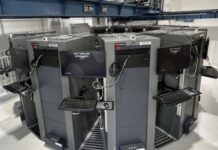Introduction
In semiconductor testing, fully automated systems manage every step of the process. Since each stage of IC production is expensive, it’s essential to identify in the early stages which dies should be discarded and which can move forward in the production cycle to help optimize costs and achieve economies of scale.
The Wafer manufacturing is a complex, step-by-step process that gradually builds the electronic circuits. In simple terms, during integrated circuit manufacturing, multiple circuits (hundreds or even thousands) are formed on a single semiconductor wafer. These circuits are then fitted with bumps for soldering or undergo wire bonding, followed by singulation. After that, the circuits are encapsulated via a molding packaging process.
Given the wafer’s small size, fragility, and delicate nature, manual handling is not feasible. This is why fully automated systems are used at every stage of semiconductor manufacturing and testing. The testing process includes advanced electrical and inspection technologies to select the appropriate wafers. Electrical testing of individual circuits is carried out by Automatic Test Equipment (ATE), which connect to the wafers through a probe card, testing for analog, digital, and mixed signals.
Wafer testing is a key step in the production cycle and adds value to the integrated circuits. It involves inspecting each semiconductor device on the wafer (which will become the core of future ICs) to identify defects and verify the functionality of the working circuits, marking them as “Known Good Die” before moving to the next production phases. Test data are collected for each IC, and a digital map is generated to show the location and pass/fail status of each die. Once the testing is complete, the wafer proceeds to the following steps in the process.
To appreciate the complexity of this testing, it’s important to understand that silicon wafers are extremely fragile, with thicknesses of just a few hundred microns (around 0.4 – 0.5 mm) and diameters ranging from 4″ to 12″ (100 mm to 300 mm). The circuits on each die are measured in microns.
Probe Card Testing
Probe card testing systems need to handle several types of tests:
- Testing individual, unassembled MLO and PCB boards (Bare Board Test).
- Checking continuity between the MLO and PCB.
- In-circuit (ICT) and functional testing of the assembled PCB.
- Testing the fully assembled probe card (combined PCB and MLO).
After testing, an ICCT (Integrity Connection Certification Test) is required to confirm the reliability of the connections between the MLO and PCB.
In order to ensure efficiency and cost-effectiveness, the automated lines must feature high flexibility and quick setup times. A complete solution requires both mechanical flexibility combined with a streamlined and user-friendly software, which are basic features of flying probe systems.
Thanks to recent advancements, these systems are becoming ideal for probe card testing, whether it’s for Bare Board Testing (BBT) or ICT and functional tests.
The test system must be able to make highly accurate probing with very small test points. Pad sizes on probe cards (on the MLO) range from 40 to 80 µm, and if bumps are used, their diameters range from 250 to 500 µm. The probe pitch needs to be extremely fine, around 70 µm, with ultra-fine pitch probes that offer a movement resolution of approximately 1 µm. At such small scales, optical performance is also essential, requiring cameras to read fiducials, inspect pads, check for missing components, and scan barcodes.
Because these boards are so fragile, the probing force of the probes must be carefully controlled to prevent damage to the pads, such as scratches or other marks. The most effective approach is to ensure vertical Z-axis movement when the probes make contact with the MLO. This method helps to ensure smooth probing without leaving traces. Any deviation from vertical Z-axis movement increases the chance of scratching the pads.
It’s also important to use the right probes for each type of test. For MLO testing, the probes should have a diameter of about 15 µm, while for PCB testing, the probes typically need a diameter of around 30 µm, with contact forces ranging from 2 to 6 grams.
Once the probe card is fully assembled and the MLO is mounted on the PCB interface, a final ICCT test must be performed to confirm that all connections between the MLO and PCB are intact.

The test system must be capable of performing all necessary tests for the individual MLO and PCB boards, such as opens, shorts, ultra-fast capacitive tests, Kelvin tests, leakage tests (with current values under 1 nA), and isolation tests up to 1000 Volts. It also needs to handle parametric (in-circuit) testing of components, including embedded ones, to check both passive components (resistors, inductors, capacitors) and active ones (like Zener diodes). Additionally, it should have the capability to test other components, such as integrated circuits and relays, which may require powering the board for proper testing.
A Key Player in the World of Microelectronics
With many years of experience in probe card testing, Seica has designed and developed the Pilot VX HR XL platform, a flying probe system that offers a comprehensive, turnkey solution for testing probe cards.
This vertical system combines hardware and software in a single platform to perform three different types of tests: testing individual MLO and PCB boards before assembly, in-circuit (ICT) and functional testing of PCBs after assembly, and final testing of the probe card, which involves combining the PCB with the MLO.
The final test includes an ICT that checks the integrity of every connection between the MLO and the PCB interface. The Pilot VX HR XL system automatically generates a specific test, taking into account the resistance of each path, which may vary due to differences in network lengths or the presence of components on the MLO.
The main hardware features of the Pilot VX HR include:
- Vertical architecture (easy to load, even for round probe cards).
- 8 fully independent axes with 1 µm movement resolution.
- 2 standard probes + 2 high-resolution probes on the front side.
- 4 standard probes on the rear side.
- Large testing area: 800×650 mm.
- Laser sensor for accurate planarity control, which can also effectively detect the presence of components and identify defects such as chip tombstoning.
- Soft landing profile.
The integrated measurement system, leveraging DSP technology, can communicate in real-time with the central unit, enabling highly accurate and precise capacitive, resistive, and inductive measurements at impressive speeds. This innovative system of stimuli and measurements is directly installed on mobile probes, allowing for “ultra-fast capacitive” testing to optimize testing times.
The Pilot VX HR can utilize any pair of standard probes to power the board up to 2A, facilitating a complete functional test. It also allows the simultaneous supply of two voltages to the board, keeping other probes free for measurements and providing maximum flexibility for powering the Device Under Test (DUT).
During the open/short test phase, continuity verification begins at 1 ohm, while insulation measurements can reach up to 10 GOhm at 1000V. The system also features a Micro-Short Identifier function.
Equipped with two high-resolution cameras, the system has a front camera with over 12 megapixels and an optical resolution of 0.9 µm, as well as a rear camera with a resolution of 10 µm, both featuring motorized focus. Additionally, there are two cameras to verify the contact position of the standard probes.
The mobile probe system includes an Automatic Stamper option, allowing for automatic marking of boards pass or fail in a previously selected marking area. This marking is done using a special ink stamp with “soft-kiss” technology.
The Pilot VX HR system, like all Seica solutions, integrates the VIVA software platform. This includes automatic generation of BBT and ICT test programs by importing CAD/CAM data in IPC-D356A (CAM350) and ODB++ formats, and provides comprehensive data output for thorough traceability of the tests performed.
The functional test sequence can be written directly within the VIVA environment, but third-party software such as TestStand or Python can also be utilized. VIVA also features the advanced graphical environment QUICK TEST (QT), which makes it easy for users to write functional tests without needing to understand the tools and matrices in depth. QT allows direct use of integrated tools to create customized tests, automatically configuring ATE tools and resource routing. All QT sequences can be saved within the VIVA program.
The Pilot VX HR can also be managed remotely via a web-based control panel, allowing operations that would typically require the operator to be present at the machine. This enables centralized control and faster setup and monitoring of the production line. The system is molding integrable with the company’s MES, thereby complying with Industry 4.0 standards.


















